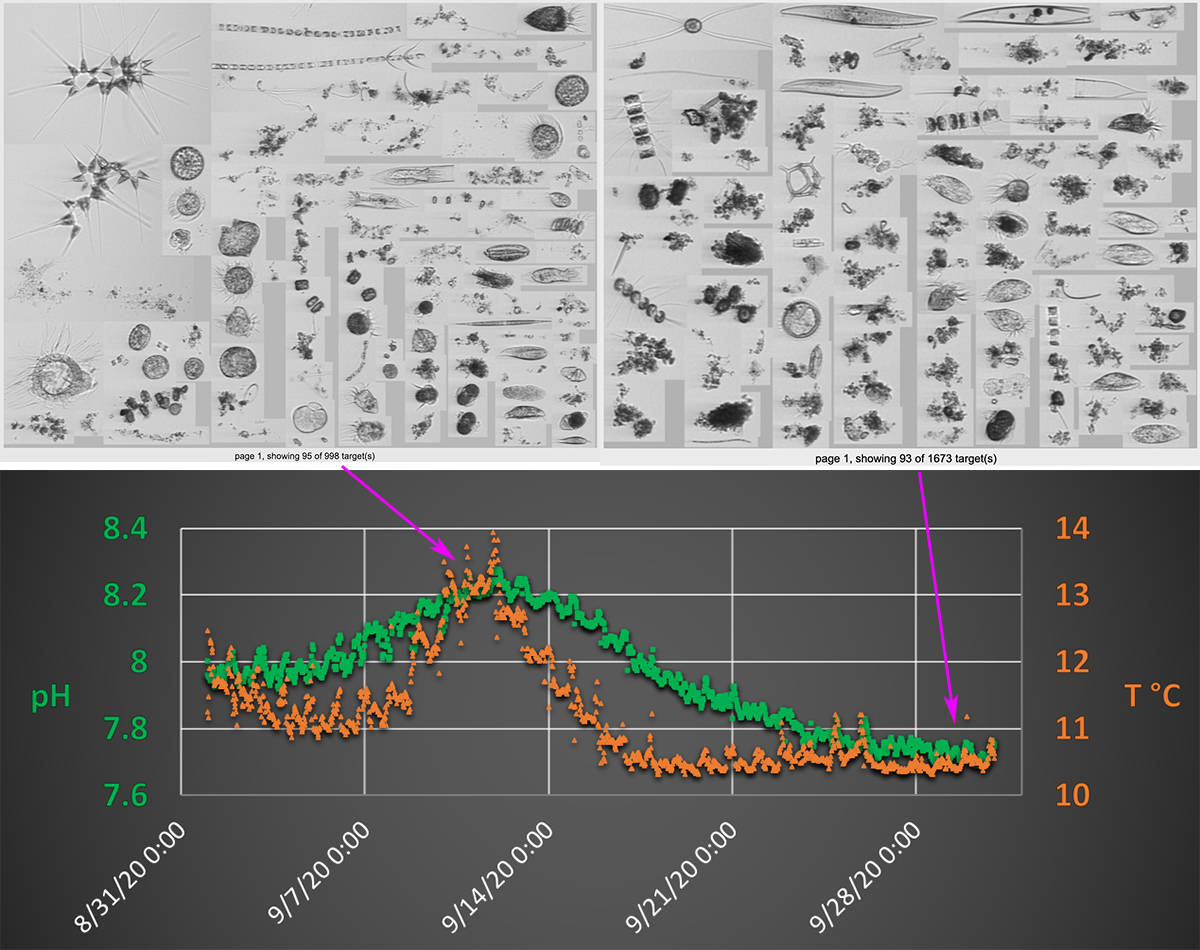Originally published by Friday Harbor Labs
by Kirk Sato (he/him)
The ocean speaks a language that is understood globally. It has been the mother tongue for generations of people who base their life’s work on its many offerings. We are privileged to work so intimately with such a powerful life source, and we also carry a great deal of responsibility as we participate in this conversation. The resources provided by the FHL Ocean Observatory allow us to translate saltwater properties into numbers, particle motions into 3D vectors and communities of microscopic organisms into high-resolution photos. These data show us how ecologically important microplankton like diatoms, dinoflagellates and ciliates interact with their saltwater environment on scales that have not been possible in FHL’s 100-plus years of existence.
Reliable data are crucial to enhancing resilience against climate change
Carbon dioxide from human activities is causing the ocean to warm and become more acidic. Environmental monitoring can help us create tailored solutions to meet specific climate change challenges. Without monitoring, we cannot determine the effectiveness of climate change mitigation actions or assess how well we are adapting.
To our knowledge, the FHL Ocean Observatory serves as the only multi-sensor array in the San Juan Islands archipelago that monitors temperature, salinity, pH, carbon dioxide, oxygen, chlorophyll-a fluorescence, turbidity, and current velocity. Time-series data sets like this describe local conditions precisely and accurately, thus providing valuable real-world context for laboratory experiments and validation of ocean forecast models.
Saltwater conditions in the Salish Sea affect fish populations (for recreational, tribal, and commercial fishers as well as iconic wildlife such as the endangered Southern Resident Killer Whales), Harmful Algal Blooms (HABs), shellfisheries, and the health of key foundation species such as eelgrass, oysters and clams. There is increasing evidence, for example, that prevalence of eelgrass wasting disease is affected both by local seawater temperatures and freshwater input. Ongoing environmental monitoring programs are crucial to help us better understand and prepare for these emerging climate-linked issues.
An unprecedented glimpse into the base of the food web
In addition to the suite of ocean properties listed above, we also monitor the microplanktonic community using a state-of-the-art camera system called the Imaging FlowCytoBot (IFCB). The IFCB is an automated imaging flow cytometer that is designed for the continuous monitoring of phytoplankton and microzooplankton. Using a laser-triggered high-resolution camera, the IFCB generates images and optical data of individual plankton and other particles in the size range of >10-150 µm (the width of a human hair).
We collaborate closely with Professor Evelyn Lessard (UW Oceanography), who is using deep learning techniques to automatically ID and count microplankton, in order to convert thousands of photos into user-friendly data in near real-time. This capacity would allow for the continuous monitoring of HAB species and would enable the development of an early alert system for Tribal, State and commercial resource managers. Also, having both ocean chemistry and detailed snapshots of the microplankton community provides an unprecedented high-resolution data set that will enable researchers to investigate the impacts of ocean change (e.g. Ocean Acidification, hypoxia, warming) and evaluate predictive ecological models.
Research community at FHL and beyond
High-resolution, long-term monitoring data are incredibly valuable to many other ongoing ecological research projects at FHL. We strive to make our data broadly accessible. I make it possible to monitor the data streams, curate them regularly, prepare them for internal peer-review and archive them online. We are working with scientists at the Northwest Association of Networked Ocean Observing Systems (NANOOS) to make the chemical data streams available to the public in near real-time. You can access the most recent curated FHL Ocean Observatory data sets through our project’s metadata webpage, http://discover.uw.edu/FEQQx00Fr3A0r0vO000Oy84 (Sato et al. 2020).
Serving the next generation
In March 2020, we were awarded a 2-year Partners in Science grant by the M. J. Murdock Charitable Trust to work with Mr. Samuel Garson, a science teacher at Friday Harbor High School. Even at the height of the pandemic when most Partners in Science projects were canceled, we developed a long-lasting partnership program that will provide FHHS students with more opportunities to learn at FHL. We believe the multifaceted Ocean Observatory is an ideal project to support local students of Friday Harbor in STEM pathways, thus supporting the passion that so many of them have for their island home and the Salish Sea.
Listening to the ocean
On its surface, FHL’s Ocean Observatory is a collection of sensors, hardware and cameras, but beneath the data there are many stories to be told about complex ocean dynamics. In order to continue producing high-quality data sets and share these lessons, we need long-term dedicated funding. Our immediate needs include routine sensor part replacements, recalibrations by the manufacturers, and regular independent water sample analyses to monitor instrumental drift. Despite this challenge, we are looking forward to coordinating with other monitoring programs at FHL such as the Smithsonian Institution’s Marine Global Earth Observatory (MarineGEO), which is focused on conducting long-term biodiversity surveys in eelgrass and kelp bed habitats. Through diverse perspectives such as those found across the FHL and UW community, I believe we can help maximize the resiliency of the ocean and envision more equitable and just ocean governance systems.
If you are interested in supporting this important work, please considering donating.
Kirk Sato is a Postdoctoral Fellow at the newly formed Ocean Nexus Center at UW’s EarthLab. Kirk’s background in oceanography and ecology is contributing to Ocean Nexus Center efforts to transform ocean governances into new systems that benefit everyone equally. This summer, he has worked to help Japanese oyster farmers build their capacity to adapt to environmental change like Ocean Acidification. He continues to serve the FHL community as the lead project manager of the FHL Ocean Observatory, which received initial NSF funding in 2015 and has been supported by the College of the Environment over the past year.



